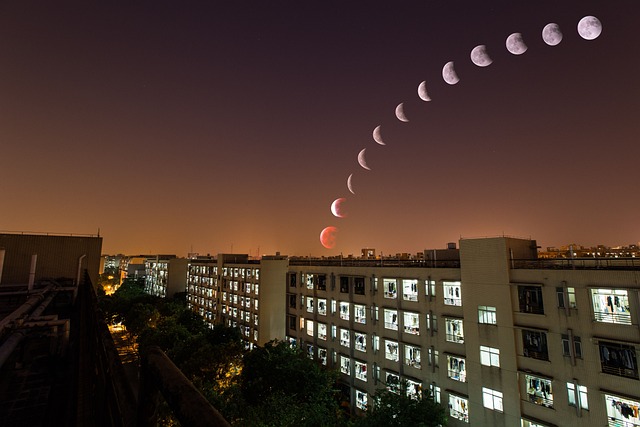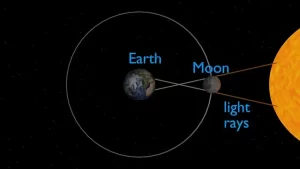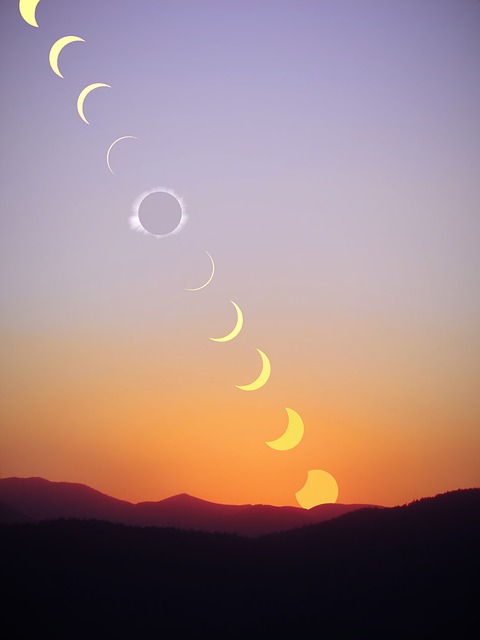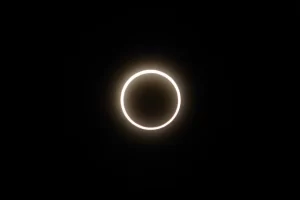Lunar Eclipses in 2025: Dates, Visibility, and What to Expect! An Eclipse Never Comes Alone! The Science Behind Eclipse Seasons!
Discover when and where to see the lunar eclipses in 2025! Learn about the total and partial eclipses, the science behind eclipse seasons, dates, visibility, and what to expect, an eclipse never comes alone, visibility maps, and tips for the best viewing experience.

1 .Lunar Eclipses in 2025
Eclipses are of two kinds: solar and lunar. Solar eclipses occur when the Moon comes between the Sun and Earth. Such eclipses are either total when the Moon completely blocks the Sun; annular, when the Moon is far from Earth and so covers the central part of the Sun, allowing the narrow ring of the Sun’s edge to shine around the Moon; or partial, when the Moon covers only some of the Sun. Lunar eclipses can be total when the Moon passes through Earth’s shadow; partial, when the Moon goes through only some of Earth’s shadow; or penumbral, when the Moon goes through only the outermost parts of Earth’s shadow and thus dims only slightly.
2 . When Are the Lunar Eclipses in 2025?
- In 2025, skywatchers will witness two lunar eclipses:
Total Lunar Eclipse: March 14, 2025
Partial Lunar Eclipse: September 7, 2025
These celestial events will offer dramatic views of the Moon passing through Earth’s shadow, with the March eclipse being the most striking.
- Total Lunar Eclipse: March 14, 2025
Key Details
–Type: Total Lunar Eclipse (“Blood Moon”)
– Visibility: Americas, Europe, Africa, and parts of Asia.
– Peak Timing (UTC):
-Partial Eclipse Begins: 04:10 UTC
– Total Eclipse Begins: 05:16 UTC
– Maximum Eclipse: 05:59 UTC
– Total Eclipse Ends: 06:41 UTC
– Partial Eclipse Ends: 07:48 UTC
3 . Lunar Eclipses in 2025- Why This Eclipse Matters
Best Regions to View:
– Asia/Australia: Evening visibility (e.g., 12:27 AM AEST to 5:55 AM AEST).
– Americas: Visible at sunset (e.g., 12:27 PM EDT to 3:55 PM EDT).
4 . What to Expect
Only a portion of the Moon will enter Earth’s umbral shadow during this partial eclipse, creating a striking “bite” out of the lunar disk. About 6% of the Moon’s surface will be obscured at maximum eclipse.
5 . Why Do Lunar Eclipses Occur?
Lunar eclipses happen when the Sun, Earth, and Moon align perfectly in a straight line (syzygy). Unlike solar eclipses, lunar eclipses are safe to view with the naked eye and can last for hours.
6 . Types of Lunar Eclipses:
– Total: The Entire Moon enters Earth’s umbra.
– Partial: Only part of the Moon enters the umbra.
– Penumbral: The Moon passes through Earth’s faint outer shadow (less visible).
 7 . An Eclipse Never Comes Alone! The Science Behind Eclipse Seasons
7 . An Eclipse Never Comes Alone! The Science Behind Eclipse Seasons
Why do solar and lunar eclipses often occur in pairs? Discover the celestial mechanics of eclipse seasons and how these cosmic events align every six months.
8 . Why Eclipses Come in Pairs—or Triplets!

The saying “an eclipse never comes alone” isn’t just folklore—it’s rooted in astronomy! Solar and lunar eclipses often occur in pairs (or occasionally triplets) within weeks of each other. This phenomenon is tied to eclipse seasons, periods when the Sun, Earth, and Moon align perfectly to cast shadows across our planet. Here’s how it works.
9 . What Are Eclipse Seasons?
Eclipse seasons happen roughly every six months, lasting about 34–35 days. During this time:
– A solar eclipse (New Moon) and a lunar eclipse (Full Moon) typically occur about two weeks apart.
– Rarely, three eclipses can happen in one season (e.g., two solar and one lunar, or vice versa).
Example (2024):
– March 25, 2024: Penumbral Lunar Eclipse
– April 8, 2024: Total Solar Eclipse
- Celestial Mechanics: The Moon’s Orbital Nodes
Eclipses occur when the Moon crosses the ecliptic plane (Earth’s orbital path around the Sun) at points called nodes. For an eclipse to happen:
Solar Eclipse: The Moon must be at a node during a New Moon(blocking the Sun).
Lunar Eclipse: The Moon must be at a node during a Full Moon (passing into Earth’s shadow).
Since the Moon’s orbit is tilted 5 degrees relative to Earth’s orbit, it only aligns with the ecliptic plane twice a year, creating two eclipse seasons.
10 . Why Two Weeks Apart?
The Moon takes about 29.5 days to orbit Earth. If a solar eclipse occurs at the start of an eclipse season, the Moon will reach the opposite node roughly two weeks later, coinciding with a Full Moon and lunar eclipse.
- Visual Breakdown:
New Moon (Solar Eclipse): Moon between Earth and Sun.
Full Moon (Lunar Eclipse): Earth between Moon and Sun.
11 . Rare Triplets: Three Eclipses in One Season
Occasionally, three eclipses can fit within a single 35-day eclipse season:
– Example: June–July 2020
– June 5: Penumbral Lunar Eclipse
– June 21: Annular Solar Eclipse
– July 5: Penumbral Lunar Eclipse
This requires the first eclipse to occur very early in the season, allowing time for a third alignment.
12 . Why Don’t We Have Eclipses Every Month?
Without the Moon’s orbital tilt, we’d see 12 solar and 12 lunar eclipses yearly. But because of the 5-degree tilt, the Moon usually passes above or below the Sun/Earth line during New and Full Moons. Only during eclipse seasons do the nodes align perfectly.
13 . Lunar Eclipses in 2025
Upcoming Eclipse Pairs to Watch
| Year | First Eclipse | Second Eclipse |
|———-|—————————–|—————————-|
| 2024 | March 25 (Lunar) | April 8 (Solar) |
| 2025 | March 14 (Lunar) | March 29 (Solar) |
| 2026 | August 12 (Solar) | August 28 (Lunar) |
14 . Cultural and Historical Significance
Many ancient cultures feared eclipses as omens, but today, they’re celebrated as scientific marvels. The predictability of eclipse seasons—calculated using the Saros cycle—showcases humanity’s understanding of celestial rhythms.
15 . Eclipses Through the Lens of Faith and Culture: Diverse Beliefs and Celebrations Across the World
How religions and cultures interpret lunar and solar eclipses—from ancient myths to modern rituals. Discover Hindu chants, Indigenous storytelling, and more!
- Eclipses as Mirrors of Belief
Eclipses have captivated humanity for millennia, inspiring awe, fear, and reverence. While science explains these events as celestial alignments, cultures and religions worldwide imbue them with spiritual meaning. From Hindu rituals to Norse mythology, here’s how eclipses are interpreted—and celebrated—across the globe.
Islam: Prayers and Humility
– Interpretation: Eclipses are signs of Allah’s power, not omens.
Surah Al-Furqan (The Criterion). This verse mentions the moon’s phases and the importance of following the lunar calendar.
“They ask you about the new moons. Say, ‘They are measurements of time for the people and Hajj.'” (Quran 2:189)
– Practices:
– Salat al-Kusuf: Special prayers during eclipses, often in the congregation.
– Charity: Encouraged to give alms and seek forgiveness.
Hadith: The Prophet Muhammad’s eclipse prayer emphasised humility and remembrance of God.
“The sun and the moon are two signs of Allah’s power. They do not eclipse for the death or birth of anyone. When you see an eclipse, pray and invoke Allah.” (Sahih Bukhari, Volume 2, Book 18, Number 151)
Christianity: Symbolism and Prophecy
– Historical Views: Medieval Christians saw eclipses as divine warnings (e.g., Christ’s crucifixion darkness).
–Modern Interpretations: Some link eclipses to Biblical prophecies (e.g., Revelation’s “blood moon”).
Prayer vigils or reflective sermons in some congregations.
Chinese Traditions: The Celestial Dragon’s Feast
– Interpretation: Ancient Chinese believed a dragon devoured the Sun or Moon during eclipses.
– Practices:
– Noise-Making: Banging drums and pots to scare the dragon away.
– Imperial Rituals: Emperors performed ceremonies to restore cosmic balance.
– Modern Observance: Many still view eclipses as omens requiring caution (e.g., avoiding travel).
Hinduism: Purification and Cosmic Battles
– Interpretation: Eclipses (Grahan are seen as inauspicious, caused by the demon Rahu swallowing the Sun or Moon.
– Practices:
– Fasting: Many avoid eating or cooking during an eclipse.
– Ritual Baths: Holy dips in rivers like the Ganges to cleanse negative energies.
– Chanting: Reciting mantras like the Gayatri Mantra ward off darkness.
– Post-Eclipse Rituals: Donating food, cleaning homes, and offering prayers.
Buddhism: Moments for Reflection
Interpretation: Eclipses symbolise impermanence and the human mind’s interplay of light/darkness.
– Practices:
– Meditation: Tibetan Buddhists may meditate on compassion during eclipses.
– Merit-Making: Performing good deeds to accumulate positive karma.
– Mythology: In Tibetan lore, eclipses occur when the planet Rahu temporarily obscures the Sun or Moon.
Norse Mythology: Wolves Chasing the Sun and Moon
– Interpretation: The wolves Sköll and Hati chase the Sun and Moon; eclipses signal their near-capture.
– Practices:
– Community Gatherings: Vikings lit bonfires to “strengthen” the Sun/Moon.
–Prophecy: Eclipses were thought to foreshadow Ragnarök (the end of the world).
Indigenous Cultures: Renewal and Storytelling
– Navajo (Diné):
– Taboos: Avoid eating, drinking, or looking at the eclipse to respect the Sun/Moon’s “rebirth.”
– Storytelling: Eclipses mark a time to share oral histories.
–Inuit: Believe the Sun and Moon temporarily leave the sky to check on Earth’s balance.
– Batammaliba (Togo/Benin): View eclipses as a time to resolve conflicts and “make peace with the Sun and Moon.”
Christianity: Symbolism and Prophecy
– Historical Views: Medieval Christians saw eclipses as divine warnings (e.g., Christ’s crucifixion darkness).
–Modern Interpretations: Some link eclipses to Biblical prophecies (e.g., Revelation’s “blood moon”).
Prayer vigils or reflective sermons in some congregations.
Ancient Egypt: The Battle of Ra and Apep
– Interpretation: Solar eclipses represented the serpent Apep attacking the Sun god Ra.
– Practices:
– Priestly Rituals: Chants and spells to help Ra defeat Apep.
– Public Ceremonies: Citizens clanged weapons to repel chaos.
Modern Secular Celebrations: Science and Spectacle
– Eclipse Festivals: Global events like the 2024 U.S. Total Solar Eclipse draw millions for communal viewing.
– Education: Museums and schools host workshops on eclipse science.
Art & Music: Inspired by eclipses (e.g., Pink Floyd’s Side of the Moon).
16 . Eclipses as Universal Teachers
Eclipses remind us of humanity’s shared curiosity, whether seen as divine messages, cosmic battles, or scientific wonders. They bridge ancient rituals and modern marvels, inviting us to look up—and inward.

17. Nature’s Perfect Timing
The phrase “an eclipse never comes alone” reflects the precision of our solar system. Whether you’re a stargazer or a science enthusiast, eclipse seasons remind us of the cosmic dance that shapes our skies—and our curiosity.
18 . How to Prepare for the Lunar Eclipses in 2025
Check Local Times: Use tools like [Time and Date’s Eclipse Calculator](https://www.timeanddate.com/eclipse/) for city-specific timings.
Find a Dark Spot: Escape light pollution for clearer views.
Use Binoculars/Telescopes: Enhance details of the Moon’s surface during totality.
Watch Livestreams: If cloudy, NASA and astronomy websites often broadcast eclipses.
19 . Cultural and Scientific Significance
– Historical Beliefs: Many cultures viewed lunar eclipses as omens; today, they’re celebrated as scientific marvels.
– Modern Research: Eclipses help scientists study Earth’s atmosphere and the Moon’s geology.
Final Thoughts- Lunar Eclipses in 2025
Mark your calendars for March 14 and September 7, 2025! Whether you’re chasing the crimson glow of the Total Lunar Eclipse or the subtle drama of the partial event, these eclipses promise unforgettable celestial shows.
PS4 Network Status Update Everything You Need to Know, How to Fix PSN Issues Quickly
Harvest Supermoon: September 18, 2024, Spectacular Event to Watch Exclusively